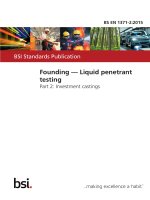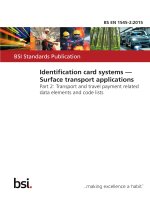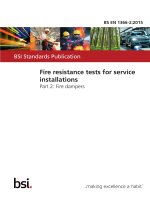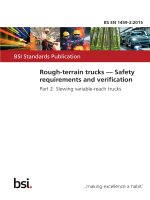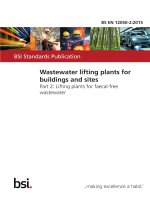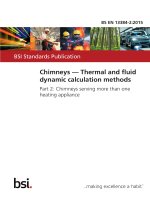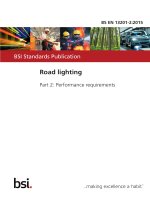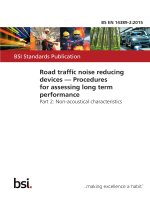Bsi bs en 10027 2 2015
Bạn đang xem bản rút gọn của tài liệu. Xem và tải ngay bản đầy đủ của tài liệu tại đây (1004.65 KB, 18 trang )
BS EN 10027-2:2015
BSI Standards Publication
Designation systems for steels
Part 2: Numerical system
BS EN 10027-2:2015
BRITISH STANDARD
National foreword
This British Standard is the UK implementation of EN 10027-2:2015.
It supersedes BS EN 10027-2:1992 which is withdrawn.
The UK participation in its preparation was entrusted to Technical
Committee ISE/100, Steel, General Issues.
A list of organizations represented on this committee can be
obtained on request to its secretary.
This publication does not purport to include all the necessary
provisions of a contract. Users are responsible for its correct
application.
© The British Standards Institution 2015. Published by BSI Standards
Limited 2015
ISBN 978 0 580 83542 1
ICS 77.080.20
Compliance with a British Standard cannot confer immunity from
legal obligations.
This British Standard was published under the authority of the
Standards Policy and Strategy Committee on 30 April 2015.
Amendments issued since publication
Date
Text affected
BS EN 10027-2:2015
EN 10027-2
EUROPEAN STANDARD
NORME EUROPÉENNE
EUROPÄISCHE NORM
April 2015
ICS 77.080.20
Supersedes EN 10027-2:1992
English Version
Designation systems for steels - Part 2: Numerical system
Systèmes de désignation des aciers - Partie 2: Système
numérique
Bezeichnungssysteme für Stähle - Teil 2: Nummernsystem
This European Standard was approved by CEN on 7 February 2015.
CEN members are bound to comply with the CEN/CENELEC Internal Regulations which stipulate the conditions for giving this European
Standard the status of a national standard without any alteration. Up-to-date lists and bibliographical references concerning such national
standards may be obtained on application to the CEN-CENELEC Management Centre or to any CEN member.
This European Standard exists in three official versions (English, French, German). A version in any other language made by translation
under the responsibility of a CEN member into its own language and notified to the CEN-CENELEC Management Centre has the same
status as the official versions.
CEN members are the national standards bodies of Austria, Belgium, Bulgaria, Croatia, Cyprus, Czech Republic, Denmark, Estonia,
Finland, Former Yugoslav Republic of Macedonia, France, Germany, Greece, Hungary, Iceland, Ireland, Italy, Latvia, Lithuania,
Luxembourg, Malta, Netherlands, Norway, Poland, Portugal, Romania, Slovakia, Slovenia, Spain, Sweden, Switzerland, Turkey and United
Kingdom.
EUROPEAN COMMITTEE FOR STANDARDIZATION
COMITÉ EUROPÉEN DE NORMALISATION
EUROPÄISCHES KOMITEE FÜR NORMUNG
CEN-CENELEC Management Centre: Avenue Marnix 17, B-1000 Brussels
© 2015 CEN
All rights of exploitation in any form and by any means reserved
worldwide for CEN national Members.
Ref. No. EN 10027-2:2015 E
BS EN 10027-2:2015
EN 10027-2:2015 (E)
Contents
Page
Foreword ..............................................................................................................................................................3
1
Scope ......................................................................................................................................................4
2
Normative references ............................................................................................................................4
3
Terms and definitions ...........................................................................................................................4
4
Principles ................................................................................................................................................4
5
Structure of steel numbers ...................................................................................................................5
Annex A (normative) Provisions and procedures for the allocation of steel numbers ...............................8
Annex B (normative) Guidance for completing forms I and II ..................................................................... 10
2
BS EN 10027-2:2015
EN 10027-2:2015 (E)
Foreword
This document (EN 10027-2:2015) has been prepared by Technical Committee ECISS/TC 100 “General
issues”, the secretariat of which is held by BSI.
This European Standard shall be given the status of a national standard, either by publication of an identical
text or by endorsement, at the latest by October 2015, and conflicting national standards shall be withdrawn at
the latest by October 2015.
Attention is drawn to the possibility that some of the elements of this document may be the subject of patent
rights. CEN [and/or CENELEC] shall not be held responsible for identifying any or all such patent rights.
This document supersedes EN 10027-2:1992.
In comparison with EN 10027-2:1992, the following significant changes were made:
a)
in 4.3 the wording was modified;
b)
in Clause 5 the number of digits for the sequential number were extended to 4 and a NOTE as well as an
explanatory text were added;
c)
the standard was revised editorially.
This document is the second Part of the European Standard "Designation systems for steels", the first Part
being "Steel names".
According to the CEN-CENELEC Internal Regulations, the national standards organizations of the following
countries are bound to implement this European Standard: Austria, Belgium, Bulgaria, Croatia, Cyprus, Czech
Republic, Denmark, Estonia, Finland, Former Yugoslav Republic of Macedonia, France, Germany, Greece,
Hungary, Iceland, Ireland, Italy, Latvia, Lithuania, Luxembourg, Malta, Netherlands, Norway, Poland, Portugal,
Romania, Slovakia, Slovenia, Spain, Sweden, Switzerland, Turkey and the United Kingdom.
3
BS EN 10027-2:2015
EN 10027-2:2015 (E)
1
Scope
1.1 This European Standard specifies a numbering system, referred to as steel numbers, for the
designation of steel grades. It deals with the structure of steel numbers and the organization for their
registration, allocation and dissemination. Such steel numbers are complementary to steel names set out in
EN 10027-1.
This European Standard is applicable to steels specified in European Standards. This European Standard
may be applied to national steels and proprietary steels.
NOTE
Although the scope of the systems is limited to steel, it is structured so as to be capable of being extended to
include other industrially produced materials.
1.2 Steel numbers established in accordance with this system have a fixed number of digits (see Clause 5).
They are better suited for data processing than steel names established in accordance with EN 10027-1.
1.3 For steels specified in European Standards the application for allocation of steel numbers (see A.6 to
A.9) is the responsibility of the ECISS Technical Committee concerned. For national steel grades, the
responsibility is that of the national competent body.
NOTE
Applications from European organizations having a specified interest in the standardization of steel and steel
products (e.g. ASD, EUROFER) are submitted via the ECISS Central Secretariat (see A.9).
2
Normative references
The following documents, in whole or in part, are normatively referenced in this document and are
indispensable for its application. For dated references, only the edition cited applies. For undated references,
the latest edition of the referenced document (including any amendments) applies.
EN 10020, Definition and classification of grades of steel
EN 10027-1, Designation systems for steels ― Part 1: Steel names
EN 10079, Definition of steel products
3
Terms and definitions
For the purposes of this document, the terms and definitions given in EN 10020 and EN 10079 apply.
4
Principles
4.1 Each steel number shall refer only to one steel grade. Conversely, each steel grade shall correspond to
one steel number. Accordingly, a number allocated to a steel shall not, in principle (see 4.3), be used for any
other steel grade (see A.1 and A.2).
4.2
Steel numbers shall be allocated by the European Registration Office in accordance with Annex A.
4.3 The European Registration Office (see A.9) shall revise the list of registered steels at appropriate
intervals. The object of such revisions is to review, in cooperation with the bodies responsible for the
application of steel numbers, those steel numbers for steels no longer in production. The revised list of
registered steels is published on the internet (www.stahldaten.de).
Steel numbers deleted in accordance with the above procedure shall not be re-allocated to future steel
grades.
NOTE
4
Information concerning deleted steel grades can be received from the European Registration Office.
BS EN 10027-2:2015
EN 10027-2:2015 (E)
4.4 Steel numbers shall not normally be changed. If, under exceptional circumstances, a change is
unavoidable, it shall be in accordance with 4.1, 4.2 and 4.3.
5
Structure of steel numbers
1.
XX
XX XX
Sequential number
Steel group number
(see Table 1)
Material group number
(1 = Steel
see Note)
NOTE
Numbers 2 to 9 of the material group may be allocated to other materials. See note to 1.1 or 1.3.
st
For allocating new steel numbers with a 4 digit sequential number it shall be ensured that the 1 two digits of
the sequential number are completely filled (e.g. 1.xx99) before allocating the last two digits of the sequential
number (e.g. 1.xx9901).
5
EN 10027-2:2015 (E)
Table 1 — Steel group number a, b
Base steels
Non-alloy steels
Quality steels
00
90
Base steels
01
91
General structural steels,
with Rm < 500 MPa
02
92
Other structural steels
not intended for heat
treatment, with Rm < 500
MPa
03
93
Steels with average
< 0,12 % C or Rm < 400
MPa
04
94
Steels with average
≥ 0,12 % C
< 0,25 % C or
Rm ≥ 400 MPa
< 500 MPa
05
95
Steels with average
≥ 0,25 C < 0,55 % C or
Rm ≥ 500 MPa
< 700 MPa
6
Special
steels
Alloy steels
Special steels
Quality steels
Tool steels
Miscellaneous steels
10
Steels
with
special
physical
properties
20
Cr
30
11
Structural,
pressure
vessel
and
engineering
steels with C
< 0,50 %
12
Structural,
pressure
vessel
and
engineering
steels with C
≥ 0,50 %
13
Structural,
pressure
vessel
and
engineering
steels
with
special
requirements
14
21
Cr-Si
Cr-Mn
Cr-Mn-Si
31
22
Cr-V
Cr-V-Si
Cr-V-Mn
Cr-V-Mn-Si
15
Tool steels
Stainless and
heat resisting
steels
40
Stainless steel with
< 2,5 % Ni without
Mo, Nb and Ti
Structural, pressure vessel and engineering steels
50
Mn, Si, Cu
60
Cr-Ni
with
≥ 2,0 % Cr
< 3 % Cr
70
Cr
Cr-B
80
Cr-Si-Mo
Cr-Si-Mn-Mo
Cr-Si-Mo-V
Cr-Si-Mn-Mo-V
41
Stainless steel with
< 2,5 % Ni and Mo,
but without Nb and
Ti
51
Mn-Si
Mn-Cr
61
71
Cr-Si
Cr-Mn
Cr-Mn-B
Cr-Si-Mn
81
Cr-Si-V
Cr-Mn-V
Cr-Si-Mn-V
32
High speed
steel
with
Co
42
52
Mn-Cu
Mn-V
Si-V
Mn-Si-V
62
Ni-Si
Ni-Mn
Ni-Cu
72
Cr-Mo
with
< 0,35 %
Mo
Cr-Mo-B
82
Cr-Mo-W
Cr-Mo-W-V
23
Cr-Mo
Cr-Mo-V
Mo-V
33
High speed
steel
without Co
43
Stainless steel with
≥ 2,5 % Ni but
without Mo, Nb and
Ti
53
Mn-Ti
Si-Ti
63
Ni-Mo
Ni-Mo-Mn
Ni-Mo-Cu
Ni-Mo-V
Ni-Mn-V
73
Cr-Mo
with
≥ 0,35 %
Mo
83
24
W
Cr-W
34
Wearresistant
steel
44
Stainless steel with
≥ 2,5 % Ni and Mo,
but without Nb and
Ti
54
Mo
Nb, Ti, V
W
64
74
84
Cr-Si-Ti
Cr-Mn-Ti
Cr-Si-Mn-Ti
25
W-V
Cr-W-V
35
Bearing
steels
45
Stainless
with
additions
55
B
Mn-B
< 1,65 % Mn
65
Cr-Ni-Mo with
< 0,4 % Mo +
< 2 % Ni
75
Cr-V
with
< 2,0 %
Cr
85
Nitriding steels
steels
special
EN 10027-2:2015 (E)
Non-alloy steels
Special
steels
Quality steels
Special steels
Tool steels
06
96
Steels with
≥ 0,55 % C or
average
97
Steels with higher P- or
S content
Stainless and
heat resisting
steels
Structural, pressure vessel and engineering steels
16
26
36
46
56
66
76
Tool steels
W, excluding
groups 24, 25
and 27
Materials
with special
magnetic
properties,
without Co
Chemically
resistant and hightemperature
Ni
alloys
Ni
Cr-Ni-Mo with
< 0,4 % Mo +
≥ 2 % Ni
< 3,5 % Ni
Cr-V with
< 2,0 %
Cr
17
27
37
47
57
67
77
Tool steels
With Ni
Materials
with special
magnetic
properties
with Co
Heat
resistant
steels with < 2,5 %
Ni
Cr-Ni
with
< 1,0 % Cr
Cr-Ni-Mo with
< 0,4 % Mo +
≥ 3,5 % Ni
< 5 % Ni or
≥ 0,4 % Mo
Cr-Mo-V
28
38
48
58
68
78
88
Materials
with special
magnetic
properties,
without Ni
Heat
resistant
steels with ≥ 2,5 %
Ni
Cr-Ni
with
≥ 1,0 % Cr
< 1,5 % Cr
Cr-Ni-V
39
49
59
69
79
89
Materials
with special
physical
properties,
with Ni
Materials
elevated
temperature
properties
Cr-Ni
with
≥ 1,5 % Cr
< 2,0 % Cr
Cr-Ni, except
groups 57 to
68
Cr-MnMo
Rm ≥ 700 MPa
07
Miscellaneous steels
18
08
Tool steels
Steels
with
special physical
properties
Other
09
29
19
98
99
Steels for other
applications
with
86
87
Cr-Ni-W
Cr-Ni-V-W
Cr-MnMo-V
Cr-MnMo-Ni
Footnotes to Table 1:
a
The classification of steel groups is in accordance with the classification of steels in EN 10020.
b
The following information is provided in the boxes of the table:
- steel group number, in upper left-hand side;
- principal characteristics of the steel group;
- Rm = tensile strength.
The limiting values for the chemical composition and tensile strength are for guidance only.
7
High strength weldable steels
Quality steels
Steels not for heat treatment by user
Base steels
Alloy steels
BS EN 10027-2:2015
EN 10027-2:2015 (E)
Annex A
(normative)
Provisions and procedures for the allocation of steel numbers
A.1 Steel numbers are allocated to steel grades in accordance with Clause 4 and specified characteristics
which include:
a)
chemical composition;
b)
characteristics as determined by standard test methods (e.g. hardness, tensile properties, impact
properties, hardenability, corrosion resistance, metallographic characteristics);
c)
suitability for processing (e.g. cold forming);
d)
suitability for specific applications (e.g. tyre cord wire).
Differences in delivery requirements which do not affect the material characteristics (e.g. type of marking,
surface appearance, dimensions) shall not be reason to allocate a different steel number.
A.2 Specification of more restrictive or supplementary requirements for the characteristics of the material
shall not normally be reason to allocate a new steel number.
A.2.1 Where a manufacturer internally restricts the specified requirements for the material characteristics for
a steel in order to reduce the probability of deviating from the specified requirements, this shall not be
considered reason to allocate a new number.
A.2.2 Where modifications or additional requirements cause a significant alteration in the characteristics of
the material, or even to changing the classification of the grade to EN 10020 (e.g. reduction in maximum sulfur
content from 0,035 % to 0,010 %), this shall be considered reason to allocate a new steel number.
For practical reasons, an existing steel number may be supplemented by an appropriate symbol or text in
order to denote certain specific requirements. Such additions do not form part of the steel number.
A.3
Steel numbers shall only be allocated to steel grades that have a commercial standing.
A.4 The justification of a new steel number shall always be verified by reference to the latest listing of
allocated numbers in order to determine the availability of a usable number (see A.12).
A.5 In accordance with 4.1 and 4.3, for a new steel number to be allocated, the characteristics (see A.1)
shall be significantly different from any other steel grade for which a steel number has already been allocated.
A.6 A request for the allocation of a steel number shall be submitted on the relevant steel number
assignment form. See Annex B.
A.7
The guidance provided in Annex B should be carefully read, and the information provided as indicated.
NOTE
The forms are designed to serve as a data input sheet to facilitate the processing of each request through to
final print out of data by electronic data processing equipment and to minimize transcription errors.
A.8 To further assist in the allocation of a steel number, the requester is asked to suggest a possible steel
group number. See Table 1.
A.9
8
Each completed application form shall be sent to:
BS EN 10027-2:2015
EN 10027-2:2015 (E)
Stahlinstitut VDEh
Europäische Stahlregistratur
Sohnstraße 65
D-40237 Düsseldorf
(www.stahldaten.de)
which will act as the appointed European Registration Office for the allocation and administration of steel
numbers.
NOTE
For an application from other European organizations (see note to 1.3), a copy of the application may be sent
directly to the European Registration Office.
A.10 The European Registration Office is responsible to ECISS, to which it shall report annually.
A.11 The European Registration Office shall inform applicants of the action taken, within 3 months. Disputes
concerning the allocation of a steel number may be referred to the Coordinating Commission (COCOR) of
ECISS by or via the responsible body (see 1.3).
A.12 The European Registration Office shall publish at appropriate intervals all the registered steels and their
steel numbers on the internet.
9
BS EN 10027-2:2015
EN 10027-2:2015 (E)
Annex B
(normative)
Guidance for completing forms I and II
B.1 Application forms
Application forms for the allocation of steel numbers are as follows, and details are attached to this annex.
a)
Form I: For the allocation of steel numbers where chemical composition is the primary specifying
criterion.
b)
Form II: For the allocation of steel numbers where mechanical properties are the primary specifying
criteria.
Before completing the forms, the requester should be thoroughly familiar with this standard and in particular
Annex A.
B.2 Steel group number suggested by the requester
The steel group number suggested by the requester shall be in accordance with this standard. While the
requester's suggestion may or may not be the number finally allocated, it will assist the registration office.
B.3 Steel name
The steel name of the steel grade shall be in accordance with EN 10027-1.
B.4 Product
Indicate:
a)
product form, using the terms in EN 10079 or suitable abbreviations, e.g.:
—
FL
= flat products
—
B
= bars or sections
—
W
= wire
—
FO
= forgings
—
C
= castings
—
TS
= seamless tube
—
TW
= welded tube
b)
thickness, in mm, preferably using ranges (e.g. ≤ 16; > 16 ≤ 40; > 40 ≤ 100; > 100);
c)
treatment condition, using the symbols in accordance with EN 10027-1, for which the specified properties
apply. See B.6.
EXAMPLE
10
FL ≤ 16 N indicates a flat product equal to or less than ≤ 16 mm thick, in the normalized condition.
BS EN 10027-2:2015
EN 10027-2:2015 (E)
B.5 Chemical composition
Express chemical composition limits as, for example, 0.13–0.18 (not .13-.18 or 0.13 to 0.18), ≤ 1.50, ≥ 0.040.
B.6 Mechanical properties
The symbols used are as follows:
Re
= specified yield strength (ReH or Rp0,2) in MPa, with an indication of the type (e.g. ReH ≥ 240)
Rm
= specified tensile strength, in MPa; (e.g. 400-650, ≤ 700)
A or A80
= minimum specified percentage elongation after fracture (see Form II)
KVmin
= minimum impact energy in Joules (J) using a Charpy-V-notch test piece:
L = longitudinal test piece
T = transverse test piece
RT = room temperature
TTKV
= maximum transition temperature in °C, of the impact energy/testing temperature curve, with KV = 27 J as
transition criterion.
B.7 Specified in
The standard or specification in which the steel grade is specified shall be indicated.
B.8 Application
Indicate application (e.g. structural steels, engineering steel, steel for case hardening, for welding electrodes,
for turbines, tool steels, for manufacturing wire ropes, etc.).
B.9 Characteristics
Indicate characteristics (e.g. suitable for cold hardening or cold extrusion, non-magnetic, etc.).
B.10 Additional information
Where the space elsewhere in the form is not sufficient for an exact description of the steel concerned, use
the space headed "Additional information".
B.11 Warning note
Organizations and individuals who deal with the allocation and administration of steel numbers take no
position with regard to the validity of any patent rights claimed in connection with any steel under
consideration. Users of steel numbers are expressly advised that the determination of the validity of any such
patent rights and the risk of infringement is entirely their own responsibility.
11
EN 10027-2:2015 (E)
Form I
The allocation of steel numbers where chemical composition is the primary specifying criterion
Requester
Name
Organization
Address
Telephone, telefax, e-mail
Information regarding
Steel number
Steel name
Producta
Form
Requester (R)
1.
Assigner (A)
1.
Cr %
Mo %
Ni %
Additional information (of R or A):
a
12
For product names use the terms and definitions in EN 10079.
Thickness
in mm
C%
Si %
Mn %
P%
S%
Condition
Specified in
Application
Characteristics
Date
EN 10027-2:2015 (E)
Form II
The allocation of steel numbers where mechanical properties are the primary specifying criteria
Requester
Name
Organization
Address
Telephone, telefax, e-mail
Information regarding
Steel
number
Requester (R)
1.
Assigner (A)
1.
Cr %
Si %
Steel name
Producta
Form
Mn %
P%
Thickness,
in mm
S%
Condition
Re
MPa
Specified in
Rm
MPa
Application
KVmin., RT
b
Amin.
A80 min.
L
J
T
J
Characteristics
TTKV, max.
L
°C
T
°C
Date
Additional information (of R or A):
a
For product names use the terms and definitions in EN 10079.
b
Delete inappropriate symbol.
13
This page deliberately left blank
This page deliberately left blank
NO COPYING WITHOUT BSI PERMISSION EXCEPT AS PERMITTED BY COPYRIGHT LAW
British Standards Institution (BSI)
BSI is the national body responsible for preparing British Standards and other
standards-related publications, information and services.
BSI is incorporated by Royal Charter. British Standards and other standardization
products are published by BSI Standards Limited.
About us
Revisions
We bring together business, industry, government, consumers, innovators
and others to shape their combined experience and expertise into standards
-based solutions.
Our British Standards and other publications are updated by amendment or revision.
The knowledge embodied in our standards has been carefully assembled in
a dependable format and refined through our open consultation process.
Organizations of all sizes and across all sectors choose standards to help
them achieve their goals.
Information on standards
We can provide you with the knowledge that your organization needs
to succeed. Find out more about British Standards by visiting our website at
bsigroup.com/standards or contacting our Customer Services team or
Knowledge Centre.
Buying standards
You can buy and download PDF versions of BSI publications, including British
and adopted European and international standards, through our website at
bsigroup.com/shop, where hard copies can also be purchased.
If you need international and foreign standards from other Standards Development
Organizations, hard copies can be ordered from our Customer Services team.
Subscriptions
Our range of subscription services are designed to make using standards
easier for you. For further information on our subscription products go to
bsigroup.com/subscriptions.
With British Standards Online (BSOL) you’ll have instant access to over 55,000
British and adopted European and international standards from your desktop.
It’s available 24/7 and is refreshed daily so you’ll always be up to date.
You can keep in touch with standards developments and receive substantial
discounts on the purchase price of standards, both in single copy and subscription
format, by becoming a BSI Subscribing Member.
PLUS is an updating service exclusive to BSI Subscribing Members. You will
automatically receive the latest hard copy of your standards when they’re
revised or replaced.
To find out more about becoming a BSI Subscribing Member and the benefits
of membership, please visit bsigroup.com/shop.
With a Multi-User Network Licence (MUNL) you are able to host standards
publications on your intranet. Licences can cover as few or as many users as you
wish. With updates supplied as soon as they’re available, you can be sure your
documentation is current. For further information, email
BSI Group Headquarters
389 Chiswick High Road London W4 4AL UK
We continually improve the quality of our products and services to benefit your
business. If you find an inaccuracy or ambiguity within a British Standard or other
BSI publication please inform the Knowledge Centre.
Copyright
All the data, software and documentation set out in all British Standards and
other BSI publications are the property of and copyrighted by BSI, or some person
or entity that owns copyright in the information used (such as the international
standardization bodies) and has formally licensed such information to BSI for
commercial publication and use. Except as permitted under the Copyright, Designs
and Patents Act 1988 no extract may be reproduced, stored in a retrieval system
or transmitted in any form or by any means – electronic, photocopying, recording
or otherwise – without prior written permission from BSI. Details and advice can
be obtained from the Copyright & Licensing Department.
Useful Contacts:
Customer Services
Tel: +44 845 086 9001
Email (orders):
Email (enquiries):
Subscriptions
Tel: +44 845 086 9001
Email:
Knowledge Centre
Tel: +44 20 8996 7004
Email:
Copyright & Licensing
Tel: +44 20 8996 7070
Email:

